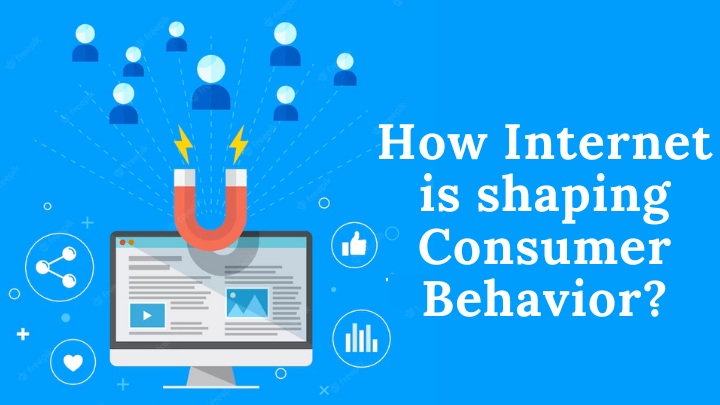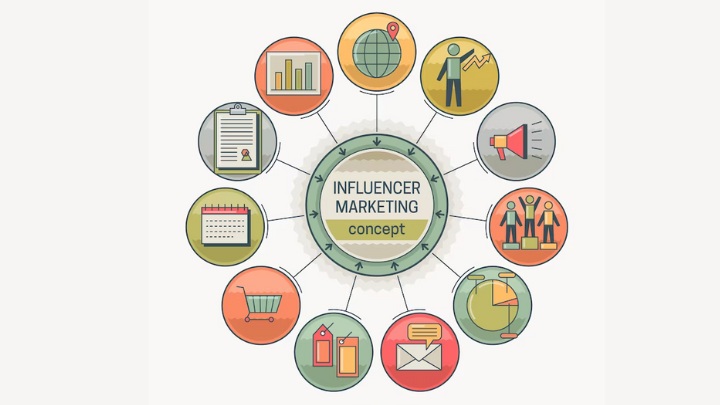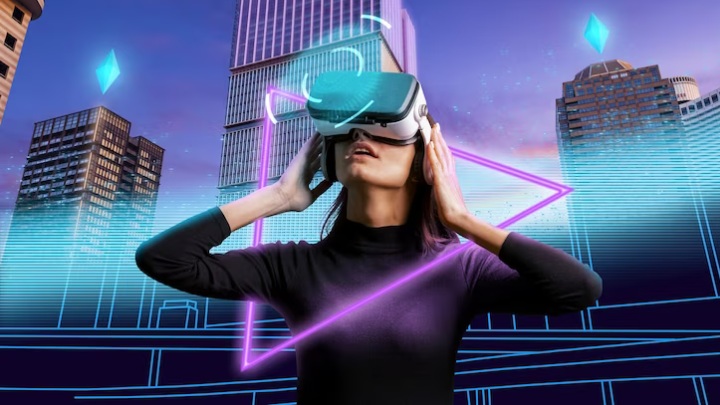
The internet has become a powerful force that is transforming the way we live, work, and interact with the world around us. One significant impact of the internet is the way it is shaping consumer behavior. Consumers, like you and me, are now more connected than ever before, thanks to the widespread availability of smartphones, tablets, and computers. It has opened up a whole new world of possibilities, enabling us to easily access information, shop online, and connect with others across the globe.
All of it has led to changes in how we make purchasing decisions, seek product recommendations, and engage with brands. This article explores the role of the Internet in modern marketing and how it shapes consumer behavior.
The internet as a global marketplace
The internet has transformed the way people buy and sell things, making it a global marketplace. It has changed consumer behavior in many ways. Now, people can now easily compare prices and products from different sellers. They can read reviews from other buyers to make informed decisions. It made online shopping so convenient. We can order things from the comfort of our homes and have them delivered to our doorsteps.
Internet also offers a wide variety of choices. We can find unique items that may not be available locally. It has opened up opportunities for small businesses to reach customers worldwide. Overall, the internet has made shopping easier, more diverse, and accessible to everyone. It had enabled seamless online transactions. On a huge landscape, online marketplaces, e-commerce platforms, and social media networks have opened new business opportunities to connect with consumers globally.
Information and research
As mentioned earlier, consumers can now research products, services, and brands in-depth before purchasing. Social media platforms also allow consumers to gather information and make informed choices. They are not dependent on only one source.
Now, we can conduct research, seek opinions from others, and explore alternatives before making a purchase. The internet has given us the ability to be smarter shoppers, allowing us to find the best deals and make choices that align with our needs and values. Internet service providers play a vital role here as they ensure a fast and reliable internet connection to all the users.
Online advertising
Online advertising refers to promoting products or services on the internet through various methods like social media ads, search engine marketing, and display banners. Through this mode of internet in modern marketing, companies can reach a vast audience and target specific demographics. They use catchy slogans, eye-catching images, and persuasive messages to grab our attention and influence our choices. It has shifted the focus from traditional media to digital platforms.
For example, have you ever searched for a new pair of shoes and later noticed shoe ads popping up on different websites you visit? It’s all tactics of online advertising. It uses tracking technologies to show ads based on your interests and browsing history. It continuously tracks us and shows us the ads that we recently searched on Google or any other search engine. With tools such as search engine marketing, display ads, and social media advertising businesses can effectively reach their target audience.
Many ads invite us to click, watch videos, or take part in surveys. These engagements make us feel involved and connected to the brand. Advertisers aim to create a positive impression in our minds, so we remember their products when making purchasing decisions.
Social media and influencer marketing
Social media platforms have become powerful tools for businesses to engage with consumers and shape their behavior. With billions of active users, platforms like Facebook, Instagram, Twitter, TikTok and YouTube allow enterprises to build brand awareness, and influence purchasing decisions. Influencer marketing, in particular, has gained significant traction as social media influencers have established credibility and trust among their followers.

Social media allows us to connect with influencers on a personal level. We see them using products, sharing reviews, and endorsing brands. This kind of marketing feels more relatable and trustworthy compared to traditional advertisements. If you want to follow it in a right manner, you must now how to sell on Instagram and other social media platforms. When we see someone we admire promoting a product, it sparks our interest and makes us more likely to consider buying it.
Personalization and targeted marketing
All these tactics of the Internet in modern marketing allows businesses to personalize marketing efforts and target specific consumer segments. Companies can gather insights into consumer preferences, behavior, and purchasing patterns through data collection and analysis. This information can deliver personalized advertisements, product recommendations, and tailored content, enhancing the consumer experience and driving sales.
Companies use advanced algorithms and data analysis to tailor advertisements specifically for you. This personalization aims to grab your attention and increase the chances of you making a purchase. By collecting information about your browsing habits and online activities, companies can understand your needs better and offer relevant products or services. This targeted marketing strategy not only benefits businesses by boosting sales, but it also enhances the overall user experience for consumers like you.
Online reviews and user generated content
Online reviews act as virtual word-of-mouth, allowing us to hear from a various range of individuals and shoppers. Consumers can now share their experiences, opinions, and recommendations through online reviews and user-generated content. These platforms play a significant role in shaping consumer behavior, as potential customers often rely on the opinions of others before making a purchase. Positive reviews and endorsements from satisfied customers can significantly influence consumer decision-making.
We can explore numerous platforms and websites dedicated to sharing reviews. Popular review websites and social media platforms like Yelp, TripAdvisor, and Amazon customer reviews have become go-to sources for many shoppers.
Convenience and accessibility
The Internet has revolutionized the way consumers shop and interact with businesses. Online shopping has become increasingly popular due to its convenience and accessibility. With just a few clicks, we can order products and services from the comfort of our homes. Gone are the days of waiting in long lines at stores or rushing to beat closing times. Consumers can browse and purchase products from the comfort of their homes, avoiding visiting physical stores. The rise of mobile devices has further enhanced accessibility, allowing consumers to shop on the go.
This convenience and accessibility have empowered consumers, allowing them to make proper choices and find the best deals. In today’s digital age, the internet is shaping consumer behavior by providing a world of options right at our doorstep.
Online communities and brand engagement
Online communities play a significant role in shaping consumer behavior and brand engagement. These communities bring people together who share common interests, hobbies, or passions. Through online platforms like social media, forums, and discussion boards, individuals can interact, share experiences, and seek advice from others. Consumers can now connect with like-minded individuals, share experiences, and engage with brands on a deeper level.
Brands recognize the power of these communities and actively engage with them. They do it by offering valuable content, personalized experiences, and responding to customer feedback. As a result, online communities have become a powerful tool for brands to build relationships, increase brand awareness, and influence consumer behavior.
Virtual Reality (VR) and Augmented Reality (AR) in marketing
Advancements in technology have brought about the emergence of virtual reality (VR) and augmented reality (AR) experiences.
Virtual Reality takes us to a whole new world by using special headsets. It creates a simulated environment that feels real and allows us to experience things that are otherwise impossible. Companies can use VR to give customers virtual tours of their products or services. By this way, it allows people to immerse themselves in virtual worlds. They can try on clothes virtually, test drive cars, or see how furniture looks in their homes before buying.
Augmented Reality, on the other hand, enhances our real world by overlaying digital information onto it. With AR, businesses can create interactive experiences that blend the physical and digital realms. For instance, you might use your smartphone to see how a piece of furniture would look in your living room or try on virtual makeup before buying it. AR helps us make better decisions by giving us a clearer picture of what we’re getting.

By this manner, AR and VR technologies make shopping more interactive and enjoyable. As the internet continues to shape consumer behavior, VR and AR are becoming powerful tools for marketers to engage and attract customers. Nowadays, you can find VR and AR apps or games easily on app stores. Social media platforms have also embraced these technologies, allowing users to share their VR or AR experiences with others. This widespread availability and social integration have made VR and AR a part of our everyday lives.
Data analytics and consumer insights
Data analytics involves analyzing huge amounts of information collected from various online sources. This data reveals valuable insights into what consumers like, how they behave, and what influences their buying decisions. By studying this data, companies can edit their products and marketing strategies to meet consumer preferences. All these gives consumer insights. These insights provide a deeper understanding of consumer needs, desires, and preferences. For example, through data analysis, businesses can identify which products are most popular among certain age groups or demographics. This knowledge helps them create targeted advertisements and promotions that resonate with specific consumer segments.
This information empowers businesses to optimize their online presence and marketing strategies. They can improve their websites to offer a smoother and more personalized shopping experience. Companies can also leverage targeted advertisements on social media platforms, reaching consumers who are more likely to be interested in their products. For example, a clothing store might notice that sales of winter coats peak in November, allowing them to stock up and launch promotions at the right time.
Customer engagement and support
Customer engagement involves building strong relationships by understanding and meeting their needs. The internet has made it easier for businesses to engage with their customers through various channels like social media, emails, and online chat. People can use these to seek assistance, making inquiries, or provide feedback. Businesses can now offer real-time support and engage with customers on various platforms, improving customer satisfaction and loyalty.
Through online reviews and ratings, people can share their thoughts about products and services, influencing others’ purchasing decisions. This has made businesses more accountable for their actions and has forced them to focus on delivering quality products and excellent customer service. This quick and efficient support has improved the overall customer experience, leading to higher satisfaction levels.
Constant connectivity and mobile marketing
With the rise of smartphones and the internet, we are always connected, no matter where we are. This constant connectivity has had a profound impact on consumer behavior and how businesses market their products. With people spending more time on their smartphones, companies can reach their target audience directly through mobile apps, social media, and even text messages.
Social media platforms like Facebook, Instagram, and Twitter have become integral to our daily lives. They not only provide a platform for people to connect and share experiences but also serve as a marketing channel for businesses. Through targeted ads and sponsored posts, companies can reach their desired audience based on their interests and demographics. This constant connectivity opens up new business opportunities to engage consumers through mobile marketing strategies. Mobile apps, push notifications, location-based marketing, and SMS marketing allow companies to reach consumers anytime, anywhere. Internet service providers are crucial in supporting mobile connectivity, enabling companies to leverage mobile marketing effectively.
Conclusion
The Internet has transformed the world of marketing and consumer behavior. It has changed the way we shop, gather information, and make decisions. With just a few clicks, we can explore a wide range of products and compare prices from different sellers. The convenience of online shopping and fast delivery options have made it more tempting to buy things instantly.
Internet service providers play a crucial role in supporting the internet infrastructure and ensuring a seamless online experience for consumers. The internet has definitely transformed the way we consume goods and services, and it will continue to shape our consumer behavior in the future.
